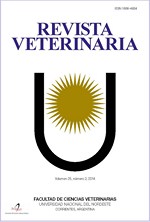Retrospective analysis of elusive follicular aspirations taking into account the quantity and quality of oocytes in brangus bovines from a livestock establishment in the Alto Paraná department
DOI:
https://doi.org/10.30972/vet.3326176Keywords:
Successive follicular aspirations, OPU, Oocyte quality, Number of oocytesAbstract
In order to carry out a retrospective analysis of successive follicular aspirations in brangus cows in a livestock establishment in the Alto Paraná department, records of 10 Brangus breed cows subjected to seven successive follicular aspirations without prior hormonal stimulation were used. In the same, the quantity and quality of oocytes obtained in the aspirations were evaluated. Regarding the number of aspirated oocytes, in an average interval of 45 days between aspirations, an average of 207 ± 14 oocytes was obtained. Statistical analysis was performed by making a random comparison between aspirations: first aspiration with fourth aspiration, finding no statistically significant differences (p> 0.05); then the 4th aspiration was compared with the 7th aspiration, resulting statistically significant (p <0.05). Regarding the number of viable oocytes per aspiration, an average of 206 ± 30 oocytes and 88 non-viable oocytes were obtained, which comparing the first with the fourth aspiration yield statistically significant results (p <0.05). Regarding oocyte quality, the results show a greater quantity of GIII oocytes, they were statistically analyzed in the following way: comparison between the first (22.4) and the fourth aspiration (20.1) of the quality of GI oocytes, GII, GIII, yielding statistically non-significant results (p> 0.05).Downloads
References
Alvarado AE, Gamarra G, Gallegos A, Samillán V. 2008. Tasa de recuperación de ovocitos en vacas Holstein en descarte. Anales Científicos 77: 1, 63-68.
Alvarado AE, Gamarra G, Gallegos A, Samillán V. 2016. Tasa de recuperación de ovocitos en vacas Holstein en descarte. Anales 2016.
Campoverde JX. 2017. Evaluación de ovocitos recuperados por Ovum Pick Up (OPU) en tiempos diferentes , luego de la estimulación ovárica.
Anales 2017.
Grisales MA, Marulanda J, Gómez JC. 2018. Relación entre calidad de ovocitos y raza de la donadora en un programa de fertilización in vitro en una Ganadería Marsella Risaralda: Anales 18.
Infostat Sofware Estadístico. 2015. Facultad de Ciencias Agropecuarias, Universidad Nacional de Córdoba, Argentina. http://www.fca.proed.unc.
edu.ar/filep hp/68/tutorial_soft.pdf.
Jairo J, Giraldo G, Ramirez SO, Oquendo JG, Betancur GR. 2017. Evaluación de la estimulación ovárica y la calidad de oocitos bovinos obtenidos por aspiración folicular. Agric Anim Sci 6: 1, 28.
López SR. 2009. Ovum Pick Up (OPU) en bovinos: aplicaciones en biotecnología de la reproducción, Anales 58-63.
Miranda RC. 2010. Efeitos do intervalo entre aspirações foliculares na qualidade de oócitos bovinos da raça gir. Trabalho de conclusão de curso apresentado ao Instituto Ciências da Saúde do UNIFOR-MG, como requisito parcial para obtenção do titulo de bacharel em Medicina Veterinária. Formiga, 2010.
Palma A. 2011. Transferencia de embriones en bovino [cited 2018 Oct 24]. Available from: http://repositorio.uaaan.mx:8080/xmlui/bitstream/handle/12345678 9/3162/MIGUEL ANGELP%C9REZ LOPEZ.pdf-sequence=1.
Quispe LC. 2018. Aspiración folicular guiada mediante la ultrasonografía con el Transductor Endovaginal Humano para la Colección de Ovocitos en Vacas Brown Swiss en Altura 2: 18.
Rolón B et al. 2019. Sistema de producción bovina para leche en la Colonia Menonita Nueva Durango, Departamento Canindeyu, Paraguay.
Trujillo HN, Fonseca HH. 2005. Aspiración folicular transvaginal. Man Ganad doble propósito 05: 4.
Downloads
Published
How to Cite
Issue
Section
License
Revista Veterinaria (Rev. Vet.) maintains a commitment to the policies of Open Access to scientific information, as it considers that both scientific publications as well as research investigations funded by public resources should circulate freely without restrictions. Revista Veterinaria (Rev. Vet.) ratifies the Open Access model in which scientific publications are made freely available at no cost online.











.jpg)
.jpg)



